Medieval History
 One of my favourite medieval churches is at Bögöz (Mugeni, RO), in Transylvania. The north wall of this church is covered with a rich ensemble of 14th century mural paintings, which were discovered in 1898. Fur much of the last 100 years, these frescoes were in a very bad condition: dirty, discoloured and crumbling. Finally, by the end of last year, the frescoes were cleaned, conserved and restored. Despite their somewhat fragmentary state, they are now much more visible.
One of my favourite medieval churches is at Bögöz (Mugeni, RO), in Transylvania. The north wall of this church is covered with a rich ensemble of 14th century mural paintings, which were discovered in 1898. Fur much of the last 100 years, these frescoes were in a very bad condition: dirty, discoloured and crumbling. Finally, by the end of last year, the frescoes were cleaned, conserved and restored. Despite their somewhat fragmentary state, they are now much more visible.
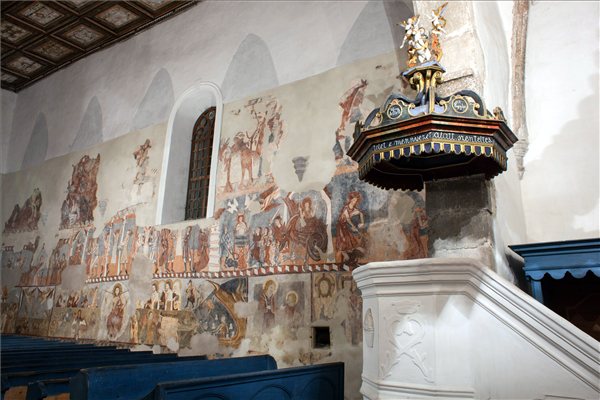
The first scene of the historia of Saint Ladislas on the western wall depicts Saint Ladislas leaving for the battle. The scene takes place in front of a large castle with three towers. Two figures are blowing horns in the castle, while in front five people pray, and a bishop blesses Ladislas, who turns back on his horse to say good-bye. The praying figures, one man and four women, are most likely donors asking for the help of their patron saint. The cycle continues on the north wall.
 The cycle illustrating the end of the world at Bögöz is at the bottom of the north wall, and it is divided into several parts. In the middle Christ in the mandorla is represented, with a robe on his right shoulder. His left side is left uncovered, and his side-wound is exposed. He lifts his arms to judge, and two swords are at his mouth. On either side of Christ the composition is divided into two tiers. In the top row first angels are represented, holding the instruments of Passion, then the Apostles follow. In the bottom row next to Christ the interceding Mary and Saint John are visible. On the left side the figure of Mary is repeated in the form of the Maria della Misericordia as well. A symbolic design, expressing the end of the world was also depicted here. The motif is composed of two circles, with the symbol of the Sun and Moon in one of them, and with a figure holding a ship in his hands in the other one. The two circles are threatened by a large snake, probably referring to the beast in the Book of Revelations.
The cycle illustrating the end of the world at Bögöz is at the bottom of the north wall, and it is divided into several parts. In the middle Christ in the mandorla is represented, with a robe on his right shoulder. His left side is left uncovered, and his side-wound is exposed. He lifts his arms to judge, and two swords are at his mouth. On either side of Christ the composition is divided into two tiers. In the top row first angels are represented, holding the instruments of Passion, then the Apostles follow. In the bottom row next to Christ the interceding Mary and Saint John are visible. On the left side the figure of Mary is repeated in the form of the Maria della Misericordia as well. A symbolic design, expressing the end of the world was also depicted here. The motif is composed of two circles, with the symbol of the Sun and Moon in one of them, and with a figure holding a ship in his hands in the other one. The two circles are threatened by a large snake, probably referring to the beast in the Book of Revelations.
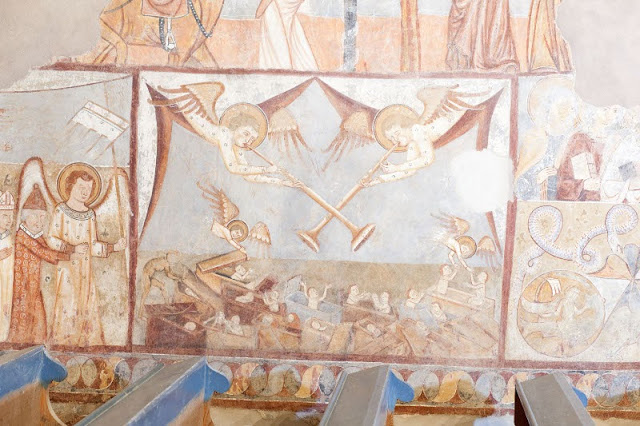
The resurrection of the dead was painted in a separate part, on the left side, with two large angels blowing horns, and the dead rising from their graves beneath them, with two smaller angels helping them. On the far left the gate of Paradise is already open, and Saint Peter is leading a pope, a bishop, a monk, a king, a queen, a man and a women towards it. The sad fate of the damned is depicted on the right side, with an angel--Saint Michael--and devils leading naked people towards the open mouth of Hell, where eternal fire awaits them. All the damned are depicted naked, except the last one, who wears fashionable clothes and a hat. Saint Michael puts his hand on the shoulder of this strange figure, and sends him to Hell. A similarly dressed man, appears in the top part of the composition, where he escapes from Hell with her unconscious lover on his back. He is heading towards the Apostles with a devil chasing him. The sources and the significance of this episode is not yet clear, but it is interesting to notice, that in the Last Judgment picture at Pet?szinnye we also see a dressed figure in Hell, carrying an unconscious woman on his back. The motif appears in the Last Judgment of Cserény as well, where one of the resurrected carries a female figure on his shoulder. Here we also see an angel, putting his hands on the shoulder of a fully dressed, praying man. The figure represented in the middle of the picture could be a donor, while the gesture of the angel is the same as in Bögöz.


- Restoration Of The Wall Paintings Of Torna / Tur?a Nad Bodvou
Detail from the Arrest of Christ (cleaned state, 2008)One of the largest restoration projects in Slovakia was completed in 2014: the restoration of the wall paintings in the sanctuary of the medieval church of Torna (Tur?a nad Bodvou). The frescoes, found...
- 800 Years Of Ják Abbey
Fresco of St. George at Ják, c. 1256 This weekend - the weekend after Saint George's Day - mark the 800th anniversary of the foundation of the Benedictine monastery of Ják. It is known that the monastery was established by Márton "the Great"...
- Medieval Wall Paintings Uncovered At Kövi/kame?any
Saint Anne with the Virgin at KöviThe village of Kövi (Kame?any, SK) lies in the vicinity of Rimaszombat (Rimavská Sobota) and Rozsnyó (Ro??ava), just north of the modern border between Hungary and Slovakia. In the middle ages, the settlement had...
- Medieval Wall Paintings Discovered At Magyarlóna
Cover of the book on Magyarlóna The village of Magyarlóna (formerly known as Szászlóna, now Luna de Sus, Romania) is a characteristic village of the Kalotaszeg region of Transylvania, near Kolozsvár (Cluj). The village was first mentioned...
- The Medieval Parish Church Of Pest (part Ii.) - A Remarkable Discovery
This post focuses on the medieval fresco decoration of the Inner City parish church of Pest - you can read my introduction to the history of the building here. Not much survived of the original painted decoration of the Inner City parish church....
Medieval History
Medieval frescoes at Bögöz restored

I wrote a small book on the church and its frescoes in the middle of the 1990s. In the following, I will give a brief overview of the monument, based on my earlier text. The text is illustrated by new photographs of the frescoes, most of which I received from the restorer, Loránd Kiss.
Before we start, have a look at the pre-restoration state of the church, on the Treasures of Szeklerland website. Select 'Mugeni' from among the churches - and take a virtual tour of the exterior and interior of the church.
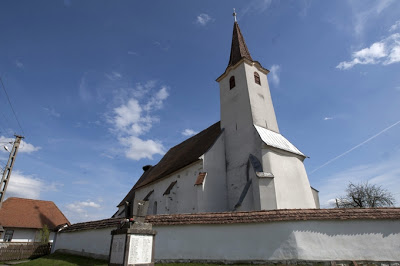 |
| Bögöz, view of the church |
The village of Bögöz is in the middle of Udvarhelyszék, on the left bank of the river Nagyküküll?. The village was first mentioned in the sources in 1333 and 1334, as part of the Archidiaconatus Telegdiensis. The settlement at that time was one of the larger villages of the area, and it maintained an important role in later centuries as well. During the fourteenth century, several noble families from the village were mentioned in documents. The sources between 1481 and 1505 often mention a certain John of Bögöz, later captain of Udvarhelyszék, who certainly must have played an important role in the late Gothic rebuilding of the church.
The church is now Calvinist, and its building is surrounded by a simple wall. The church consists of three main parts: a large western tower, nave and sanctuary. The simple nave and the bottom parts of the tower are still from the Romanesque period, and the foundations of the original, semicircular apse were discovered inside the present late Gothic sanctuary. Thus the original church must have been built in the 13th century. The nave had been vaulted with a net-vaulting probably at the end of the fifteenth century, but this vaulting was later destroyed, and only the corbels in the wall survived. The nave is now covered with a painted coffered ceiling from 1724. The elaborate stone-vaulting of the sanctuary and its sculpted corbels have survived up to the present day.

The wall-paintings of the church are preserved on the north wall of the nave. József Huszka discovered them in the summer of 1898, and published his results and copies in the same year. The present condition of the paintings can be compared with the two sets of Huszka?s copies - the sketches in the Ethnographic Museum, and the final versions in the collection of the OMvH.
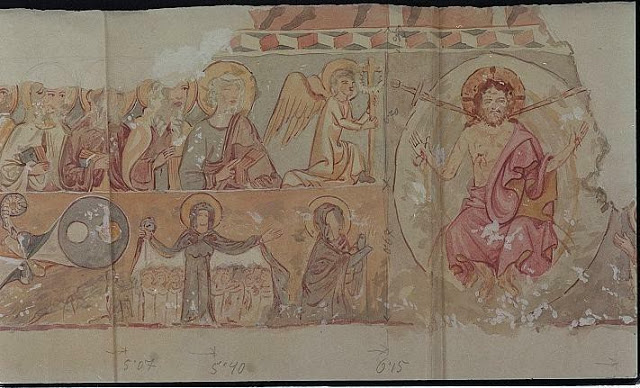 |
| Detail from the copy of József Huszka, 1898. Budapest, Museum of Ethnography |
The comparison shows that the frescoes are in almost the same condition now as in his time. The wall-paintings were covered shortly after Huszka had discovered them, and were cleaned again only in the 1930s and finally in 1966-67. They have never been fully restored until 2012. There are three cycles on the north wall. The cycle depicting Saint Ladislas in the battle of Kerlés remains in the top row only in fragments. The cycle begins on the west wall, where it has survived quite well. The legend of Saint Margaret is depicted in the middle row, while a large Last Judgment is situated in the lower row.
| First scene of the Legend of St. Ladislas, before restoration |
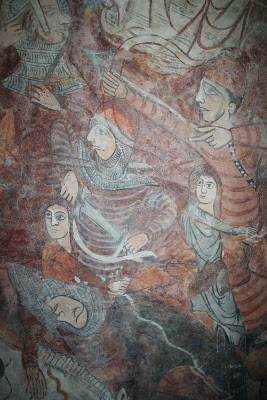 |
| Detail from the Legend of St. Ladislas |
Five painted fragments survived between the corbels of the late Gothic vault. The first two belonged to the large scene depicting the battle against the Cumans. On the first fragment we only see the legs of running horses and dead Cuman bodies among them. The second fragment is the largest of all, containing the figures of several Hungarian warriors chasing the pagans, who shoot arrows back at them. Two of the Cumans carry an abducted girl on their horse. In the third scene the figure of Ladislas chasing the Cuman is still visible. A large nineteenth-century window damaged a substantial part of the fresco; nevertheless, to its right the fourth scene (fragmentary) depicting the warriors? bare-handed combat is discernible, although only the figure of Ladislas has remained more or less intact. The last fragment is from the scene of the beheading. The prince holds the head of the defeated Cuman, while the rescued girl prepares to cut the heathen?s neck.
 |
| Detail from the Legend of St. Margaret |
The legend of Saint Margaret of Antiochia is in the middle row of the north wall, under the legend of Saint Ladislas and above the Last Judgment. There are eleven scenes in the cycle, some of them in a fragmentary state. In the first scene the prefect Olybrius sends a servant to Margaret to ask for her hand in marriage. Margaret goes to Olybrius, but refuses him. Olybrius, represented as a king, orders Margaret to be tortured. In the fourth scene she is flagellated, then tortured with pincers, and then is depicted again in a third torture scene. In the next scene we see Olybrius praying in front of an idol on a column. Margaret is then boiled in hot oil, and later she is put into prison, where she defeats the devil twice, once in the form of a dragon. The dragon swallows her, but she miraculously emerges behind him with two crosses in hand. In the last scene she is beheaded. Although some scenes are fragmentary, the whole cycle is in relatively good condition. Certain parts in the first section of the cycle are still covered with whitewash--those parts had been covered by the eighteenth century wooden gallery until 1967.
| St. Margaret |


The resurrection of the dead was painted in a separate part, on the left side, with two large angels blowing horns, and the dead rising from their graves beneath them, with two smaller angels helping them. On the far left the gate of Paradise is already open, and Saint Peter is leading a pope, a bishop, a monk, a king, a queen, a man and a women towards it. The sad fate of the damned is depicted on the right side, with an angel--Saint Michael--and devils leading naked people towards the open mouth of Hell, where eternal fire awaits them. All the damned are depicted naked, except the last one, who wears fashionable clothes and a hat. Saint Michael puts his hand on the shoulder of this strange figure, and sends him to Hell. A similarly dressed man, appears in the top part of the composition, where he escapes from Hell with her unconscious lover on his back. He is heading towards the Apostles with a devil chasing him. The sources and the significance of this episode is not yet clear, but it is interesting to notice, that in the Last Judgment picture at Pet?szinnye we also see a dressed figure in Hell, carrying an unconscious woman on his back. The motif appears in the Last Judgment of Cserény as well, where one of the resurrected carries a female figure on his shoulder. Here we also see an angel, putting his hands on the shoulder of a fully dressed, praying man. The figure represented in the middle of the picture could be a donor, while the gesture of the angel is the same as in Bögöz.

The decoration of the nave is completed with three separate compositions on the right side of the Last Judgment: the first one is Saint Dorothy with the figure of Jesus as a child; the second is a fragment of the vera icon image and a standing female saint, the legendary Saint Veronica; the third one originally represented three saints, but it is so fragmentary now that they can not be identified. There are traces of a fourth painted row below the Last Judgment, most likely some kind of ornamental or curtain-like decoration. No wall-paintings have been discovered on the other walls of the church.
The frescoes were painted in three major periods. The legends of Saint Ladislas and Saint Margaret were completed first. Their date has been debated extensively, and because of the fragmentary state of the Ladislas cycle and the heterogeneous style of the legend of Saint Margaret this debate is not easily settled. Along with the linear Gothic elements perceivable in both cycles and comparable to the Saint Catherine cycle at Gelence and other examples found in other churches, the cycles also contain several Romanesque elements, especially the clothing style of the figures in the legend of Saint Margaret. Based on these stylistic qualities, and taking the iconographic factors also into account, the frescoes can be dated to the first decades of the fourteenth century.
The Last Judgment cycle was painted later, as the area in the western part shows, where a sizable part of the legend of Saint Margaret is covered by the Last Judgment. The Last Judgment contains several stylistic and iconographic elements from the Italian Trecento, such as the figures of the angels above the resurrected dead, or the apostles on the two sides of Christ. The position and form of the angels is similar to the details of the Last Judgment fresco at Pet?szinye, dated to 1330-1350. Another interesting comparison can be made with the frescoes on the north wall in Gömörrákos, where a large Last Judgment composition, containing similar elements as the one at Bögöz, was painted below the legend of Saint Ladislas. This monument was dated to the 1380s. Taking all these stylistic and iconographic parallels into account, the cycle of Bögöz can be dated to the second half of the fourteenth century. The three additional scenes were painted later then the Last Judgment. They are painted on a different layer, and the style of these separate images points to an early fifteenth century date.

The cycles painted in the first period depict the legends of two highly important saints, who were represented together in other churches as well, such as at the neighboring Homoródszentmárton. Ladislas defeats the pagan Cuman, while Margaret is battling with the pagan Olybrius and with the devil itself. Although the Ladislas cycle is fragmentary today, we can see that conscious effort was made to match the elements. This is particularly apparent in the last episodes, where even the movement of Margaret holding the defeated demon is the same as the gesture of Ladislas seizing the vanquished infidel. In some of the western examples the legend of Saint Margaret is paired with the legend of Saint George, who also defeated the dragon. Sometimes they are even represented within the same cycle, where Margaret becomes the princess of the legend of Saint George. At Bögöz and some other Hungarian examples the legend of Saint Ladislas is represented instead of the legend of Saint George. The triumphant knights and the martyred virgins are paired as examples, as they all fought against the enemies of Christianity - but while the men defeated the dragon and also the pagans, the women suffered their triumphant death by pagan hands. A very similar arrangement is found in Homoródszentmárton. The similarity is so striking that we have to suppose a common model that both of these churches followed.
The meaning of the two holy examples was enriched with the addition of the Last Judgment. The large composition reveals the prospects of Heaven to everyone, but also displays Hell and its tortures for those who do not follow the example of the saints. Thus the frescoes together form a compendium of late medieval believe systems.
The meaning of the two holy examples was enriched with the addition of the Last Judgment. The large composition reveals the prospects of Heaven to everyone, but also displays Hell and its tortures for those who do not follow the example of the saints. Thus the frescoes together form a compendium of late medieval believe systems.
 |
| View of the restored frescoes |
The results of the restoration were presented to the public on November 24, 2012. You can find a good photo documentation of the frescoes on the photo blog of Attila Csed?, the source of the photo above. More information on the ongoing restoration of the church is available (in Hungarian) on the website of the Új Évezred Alapítvány, which supported the restoration.
- Restoration Of The Wall Paintings Of Torna / Tur?a Nad Bodvou
Detail from the Arrest of Christ (cleaned state, 2008)One of the largest restoration projects in Slovakia was completed in 2014: the restoration of the wall paintings in the sanctuary of the medieval church of Torna (Tur?a nad Bodvou). The frescoes, found...
- 800 Years Of Ják Abbey
Fresco of St. George at Ják, c. 1256 This weekend - the weekend after Saint George's Day - mark the 800th anniversary of the foundation of the Benedictine monastery of Ják. It is known that the monastery was established by Márton "the Great"...
- Medieval Wall Paintings Uncovered At Kövi/kame?any
Saint Anne with the Virgin at KöviThe village of Kövi (Kame?any, SK) lies in the vicinity of Rimaszombat (Rimavská Sobota) and Rozsnyó (Ro??ava), just north of the modern border between Hungary and Slovakia. In the middle ages, the settlement had...
- Medieval Wall Paintings Discovered At Magyarlóna
Cover of the book on Magyarlóna The village of Magyarlóna (formerly known as Szászlóna, now Luna de Sus, Romania) is a characteristic village of the Kalotaszeg region of Transylvania, near Kolozsvár (Cluj). The village was first mentioned...
- The Medieval Parish Church Of Pest (part Ii.) - A Remarkable Discovery
This post focuses on the medieval fresco decoration of the Inner City parish church of Pest - you can read my introduction to the history of the building here. Not much survived of the original painted decoration of the Inner City parish church....
